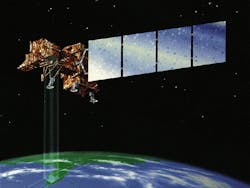IARPA kicks-off satellite electro-optical sensors project to detect and characterize events over time
WASHINGTON – U.S. intelligence experts are asking industry to blend data from satellite-based multispectral imaging sensors and visible-light sensors to detect heavy building projects and highway construction from space.
Officials of the U.S. Intelligence Advanced Projects Agency (IARPA) in Washington has released a broad-agency announcement (IARPA-BAA-19-04) for the Space-based Machine Automated Recognition Technique (SMART) project.
SMART will rely on geographical information from satellite cameras, and develop multi–spectral and multi–temporal sensor processing to overlay data from infrared and multispectral sensors to make the intelligence analyst's job easier. IARPA is the research arm of the U.S. Director of National Intelligence.
Many space and airborne sensors today can provide imagery suitable for geographical intelligence (GEOINT). SMART will demonstrate that GEOINT gleaned through data fusion is greater than the simple sum of GEOINT gleaned from several electro-optical sensor images analyzed in the absence of other imagery.
Related: EO/IR sensors boost situational awareness
The idea is to reduce uncertainties inherent in single-sensor data, and reduce the sheer amount of intelligence imagery data that can overwhelm intelligence analysts by developing tools to help analysts analyze intelligence imagery using Big Data, IARPA officials say.
The volume of GEOINT data continues to grow, while analysts struggle with the volume, variety, and velocity of space-based data. IARPA is seeking automated broad-area search, monitoring, and analysis of man-made activities based on data fusion of spectral and temporal space-based imagery.
While one sensor may have resolution sufficient to detect changes and man-made disturbances, intelligence experts still struggle with the inability to analyze images over time because of infrequent satellite orbits or weather cover.
IARPA experts want to push the technology state of the art in high-performance analytics that scales to extremely large data sets; data mining, ranking and visualization; and image analyst tools like automated broad-area search of man-made processes.
By blending data from several different electro-optical sensors, IARPA experts want to improve the ability to detect and monitor man-made disturbances to track the progress of major construction projects.
The SMART program’s primary objective is to develop tools and techniques for automated broad-area search to detect, monitor, and characterize the progression of natural or man-made events or activities using time-series spectral imagery from several space-based or airborne sensors.
Examples include heavy construction; real estate or urban development; crop disease propagation; forest fires, severe weather consequences such as flooding and mudslides; insect or battle damage; human migration; mining, logging, farming; and earthquakes.
Applications range from geospatial intelligence, disaster recovery, and humanitarian aid, to automated assessment of land-use for commercial purposes. The project has two technical areas: data fusion, and algorithms to detect and characterize natural and man-made events.
Data fusions seeks to quantify data quality and cross-sensor inconsistencies in time-series satellite imagery, and develop automated data calibration techniques. Algorithms seeks to develop algorithms capable of broad-area search over areas larger than 8,000 square meters.
Algorithms will use spaced-based time-series imagery to detect and locate evolving natural or man-made events, and analyze the progression of these activities.
Companies interested should submit proposals no later than 7 April 2020 to the IARPA Distribution and Evaluation System online at https://iarpa-ideas.gov.
Email questions or concerns to Torreon Creekmore, the SMART program manager, at [email protected]. More information is online at https://beta.sam.gov/opp/103b342c8a864c45843bc93d321ed47f/view.
